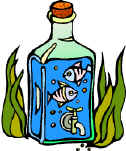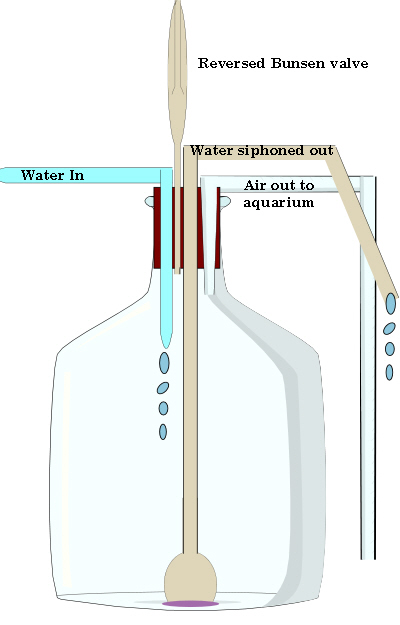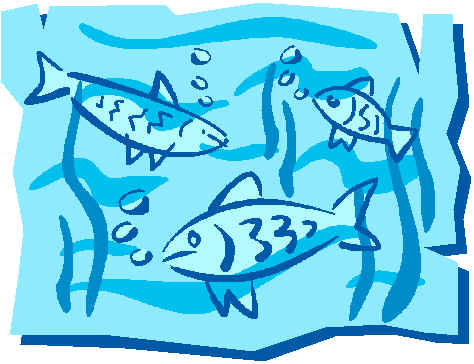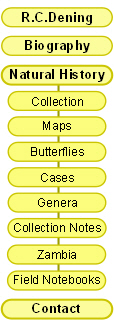Aquaria
Notes on setting up, stocking and keeping aquaria, written by Richard (Tim) Dening
in the 1930's, while he was at school at Bradfield College, in South East England.
Editor's Note

In this article I will begin be stating
how to obtain and lay out an aquarium and will then endeavour to show how the aquarium may
be kept going and how it may be stocked.
How to obtain an aquarium.
A cheap form of glass aquarium can be
obtained from electricians. These are old accumulator cells and should be well washed
before use, to remove any chemicals. They vary slightly in size. These aquaria are are
extremely useful for those who are intending merely to keep tadpoles or sticklebacks.
However, those who wish to keep small Perch, Roach or other fish larger than sticklebacks,
should obtain a larger and more expensive aquarium, an average size being about 4 feet
long by 2 feet wide and about 2 feet in height. Mature Perch and Roach will not live for
long in smaller aquaria. A mature Perch or Roach does not necessarily mean a large one.
How to lay out an aquarium
The bottom of an aquarium should be
covered with sand, preferably from the bottom of a pond or stream, as this contains small
insects, crustacea, snails and other minute organisms. The sand should be about one inch
deep. Water weed of various kinds should be planted in the following way. the roots should
be placed in a cloth bag containing earth and a stone and the bag tied up. The weed can
then be sunk in any suitable place. Weed is absolutely essential in an aquarium. In the
light it gives off oxygen, which partly dissolves in the water, thus aerating it. weed is
present in all ponds and streams where there are fish, and if none is placed in the
aquarium, the balance of nature is upset and the fish will probably die of suffocation
unless artificial aeration is installed. A few small stones should be strewn about the
bottom of the aquarium.
When the water is added, it should be run
in from a tap through a piece of rubber tubing, care being taken not to stir up the sand
unduly. In spite of these precautions the aquarium is sure to be muddy at first. In a day
or two the mud will have settled, still leaving the water cloudy. Each day about half the
water should be removed and replaced by fresh. After several treatments of this kind, the
aquarium will soon clear, and it will be found that on adding water, the mud is no longer
stirred up. A large aquarium should be arranged so that it forms a cross section of a
stream or river. Therefore, the sides should be banked up to about half the height of the
aquarium, with a deep part in the middle.
How to keep the aquarium
going
It is essential that enough water be taken
out of the aquarium and replaced by fresh each day, so that the water may never become
tepid, if it happens to be in a warm place. If this is not done, many fish will probably
die of suffocation. It is therefore advisable to keep an aquarium in a cool place to avoid
the necessity of always changing the water. If a small aquarium contains such fish as
minnows, it is essential that the water be changed in the above way at least once a day.
On the other hand, if the aquarium contains carp or sticklebacks, it need only be changed
when it is noticed that the fish are breathing quickly, which indicates that there is not
enough dissolved oxygen in the water or that the water is becoming stagnant.
A large aquarium should always be kept in
a cool place, since continually changing the water is very inconvenient, especially as the
aquarium takes so long to drain. If the aquarium must be in a warm place, a system of
running water can be arranged, by which fresh water runs in at one end from a tap and is
siphoned out at the other end. But even if the aquarium is in a cool place, the water must
not be allowed to become stagnant. An electrical apparatus for pumping air into an
aquarium can be bought for about £2 10s. However, there is a far simpler and cheaper
device for pumping air in.
A large bottle should be obtained for the
purpose, fitted with an air-tight rubber cork. Four holes should be made in the cork, into
which are fitted two plain tubes, one for water inlet, one for air outlet, one siphon tube
with a thistle funnel at the end and one reversed bunsen valve. The whole apparatus must
be air-tight.

The water flowing in from the top forces
air into the aquarium. As the bottle fills, the pressure increases, until it becomes great
enough to force the water out of the bottle through the siphon tube, the bottle
automatically emptying itself. In this way, air is kept continually bubbling into the
aquarium without any trouble at all and the water is kept continually on the move.
An aquarium containing fish should be
plentifully supplied with small insects and crustacea from the bottom of ponds. A little
bread should always be supplied, but not rolled up into balls, when it will swell inside
the stomach of the fish. Perch and Pike should be supplied with small minnows or other
small fish from time to time.
In small aquaria fish are liable to get
out of condition and get fungus growths on their fins, gills and scales, which often prove
fatal. As soon as this is noticed they should be placed for about 30 seconds in a strong
solution of potassium permanganate and then washed under a cold tap.
It will be found convenient to paint the
back of a large aquarium green and to have a lighting apparatus. The aquarium should never
be filled to less than two inches of the top, unless it has a covering, as fish,
especially minnows and Pike, often attempt to jump out. The covering should be perforated
to admit air, perforated zinc being best.
Stocking the aquarium
Perch
The Perch likes slowly moving rivers and
canals. It is extremely common in the Thames. In some places large numbers may be seen
close to the shore. These are about the right size for an aquarium. They must
be placed in a large aquarium. They are very difficult to catch with a net alone. A minnow
on a bent pin should be used, but not a hook, as it is only necessary to keep the fish on
the pin until the net can be brought into play, and hooks damage the fish.
The Perch cannot be mistaken, as its back
and sides are striped. The Perch in its first year is semi-transparent, in its second year
is white beneath and dull green above, and in its third year it becomes mature. The record
Perch caught by fair angling in the British Isles weighed 5lbs 4 ozs and was caught at
Woodley, Berks. The heaviest Perch on record is a 10 pounder from Lake Bala.
Bullhead or Miller's Thumb
The Bullhead is common in most clear.
stony, swift-running streams.It lives on the bottom of the stream beneath stones. It is
very common at Blue Pools. The Bullhead looks much like a Gurnard, a slat-water fish. It
is an extremely hardy fish. It feeds on small insects and crustacea on the bottom of
streams, although at times it will attack and kill fish as large as itself. Many people
think that they always die in an aquarium. This however, is not the case. Naturally, if
the water in the aquarium becomes warm, much of the oxygen is expelled, and the Bullhead,
being accustomed to ice-cold, well-oxygenated stream water will die. On the other hand, if
the water is kept cold and well-oxygenated, they will live a long time. Bullheads lay
their eggs beneath stones, where the male guards them until they hatch. these eggs may be
found by turning over large stones. The Bullhead can change its colour from time to time.
Sticklebacks

There are two fresh-water species of
sticklebacks, the three-spined and the ten-spined. Three-spined Sticklebacks are common
everywhere around Bradfield. Ten-spined Sticklebacks can be caught in the water-cress
beds. The Ten-spined Stickleback is yellower, smaller and more slippery than the average
Three-spined Stickleback and has ten spines on its back instead of three. In both species
the male makes a nest, in which the female lays her eggs, which the male guards until they
hatch. The male Three-spined Stickleback becomes bright red underneath in the breeding
season. The females become very large on account of their eggs. If they are wanted to nest
in an aquarium, a pair must be isolated with plenty of weed and the water kept
well-oxygenated.. Two males must never be put together, as they will fight to the death.
Salmon, Trout and Grayling 
Specimens of these three fish can rarely
be kept in an aquarium without running water. The Salmon of course cannot be caught round
Bradfield, as the Thames is so polluted near its mouth that Salmon cannot ascend it.
Otherwise, the Thames might be one of the best Salmon rivers in England. There are so many
books on the Salmon that may be read by anyone interested, that I shall leave the subject
now. The record Salmon caught by fair angling weighed 64 lbs. The heaviest Salmon on
record is one of 103 lbs.
The Trout is an extremely variable fish.
It varies a great deal according to its age and sex. No less than ten sub-species of the
Common Trout have been described. Besides these, there are two other acclimatised species
of trout, the Brook Trout and the Rainbow Trout. The record trout caught by fair angling
weighed 39.5 lbs, and was caught in Loch Awe. The heaviest river trout taken by fair
angling weighed 20 lbs and was caught in the Kennet at Newbury.
The Grayling prefers water which is at a
slightly higher temperature than that of most trout streams, though both fish often live
together in the same river. The heaviest Grayling taken by fair angling weighed 4 lbs 9
oz., from the River Wyly, at Bemerton, Wilts., and the heaviest Grayling on record weighed
5 lbs.
Pike
The Pike is a fish well-known for its
predatory habits. There are several cases on record of Pike devouring Salmon of their own
size. An average weight for a large Pike is about 30 lbs. The record caught by fair
angling weighed 53 lbs, and was taken in Lough Conn. The heaviest Pike on record is a
72-pounder from Loch Ken. Distinguishing features of the Pike are its long body and
unusually long snout.
Small Pike, an inch or two long, can often
be seen close to the banks of canals. They are extremely difficult to catch owing to the
speed of their movements. Very often it is quite impossible to follow them with the eye,
the only indication being a swirl of water. These Pike live extremely well in aquaria
large or small. They may be put in an aquarium with other fish as large as themselves,
provided they are well-fed; otherwise they will attack the other fish. About once a week
they should be supplied with ten to fifteen small fish such as small minnows. They will
probably eat them at once and for some time their stomach will have a swollen appearance.
These small Pike are very apt to jump out of an aquarium, so that must be guarded against.
Carp
Their are three varieties of carp in this
country (England), the Common Carp, the Crucian Carp and the Golden Carp. The
Common Carp differs from the other two in having barbules or 'whiskers' round its mouth.
It is hard to distinguish between the Crucian Carp and the Golden Carp. The carp caught at
Bradfield are either Crucian Carp or Golden Carp, perhaps both. All three carp are
regarded as having been originally introduced by the monks, and the ponds containing carp
at Bradfield are very probably the ponds in which the monks of the monastery cultivated
their carp. Carp are extremely hardy fish and they will travel long distances out of water
if packed in damp moss. The record carp caught by fair angling weighed 20 lbs 3 oz., and
the heaviest on record weighed 24 lbs 8 oz. and was taken in the Great Pond at Harting,
near Petersfield. Crucian Carp only attain a weight of 5 lbs.
Gudgeon
The Gudgeon is common in most rivers,
where there is sufficient refuse on which it can feed. It is common under bridges in the
River Kennet. It has dark markings, is a long fish and has two barbules round its mouth.
Minnow
This is one of the commonest fish found in
British waters. It is common in most swiftly-running streams and rivers and prefers to
live under bridges. It has a short snout, cylindrical body and dark vertical bars
descending from the back. In the breeding season, the male develops white tubercles on its
head, and becomes black and red underneath. Also its pectoral fin becomes thickened.
Dace
The Dace is a slender and very graceful
fish. Its dorsal and anal fins are concave on the edge. The Dace prefers clear, cold
streams, and is thus found in trout streams. The record Dace caught by fair angling
weighed 1 lb 8 oz. and was taken in the River Ivel.
Roach
The Roach prefers slow-moving rivers and
canals. The fish when young lacks the red fins and may be confused with the Dace. But the
Dace prefers swifter water than the Roach. The Thames contains Roach, but they are
extremely crafty fish. The heaviest Roach caught by fair angling weighed 3 lbs 10 oz. and
the heaviest Roach on record weighed half an ounce more.
Bleak
This fish lives on the surface of rivers
and lakes. It is a small. lively, silvery fish. It is very common in the Thames. From its
scales is produced the silver essence used in the manufacture of artificial pearls.
Loach 
There are two species of loach found in
British waters, the Stone Loach and the Spined Loach. Both have six barbules. The Stone
Loach has two long, four short barbules, the Spined Loach, six of equal length. They are
long fish which live on the bottom of streams and ponds. They can breathe air, so that if
their pond dries up, they can still live in the mud in a torpid condition. In this they
are unusual. In badly aerated aquaria, they rise to the surface and swallow a bubble of
air. There are loach in the Pang.
Lampreys
There are three main varieties of
lampreys, those are the Sea Lamprey, the River Lamprey or Lampern and the Brook Lamprey.
The Sea Lamprey spends most of its life at sea, and is often found clinging to Basking
Sharks and other large fish. It grows to the largest size. The Lampern does not stay so
long at sea, but lives in the rivers. The Brook Lamprey is the smallest and does not visit
the sea at all. It is typical of King John that he died of grossly overeating lampreys.
Probably all three lampreys are varieties of one species, as intermediate forms are found.
Hybrids
It must be remembered that hybrids are
occasionally caught. These are rare and exceptional. The main hybrids are hybrids between
Bleak and Chubb, Bleak and Dace, Bleak and Roach, Bleak and Rudd, Bleak and White Bream,
Bream and Roach, Bream and Ruddy Carp and Crucian Carp, Perch and Ruffe, Roach and Rudd
and White Bream and Rudd.
In this article I have not mentioned the
water insects and snails with which an aquarium may be stocked. Small crayfish live
tolerably well in a small aquarium, and larger ones will live in a large aquarium,
provided the water is oxygenated; if it is not, they will die at once.
Bibliography
The Freshwater Fishes of the British Isles
by C.Tate Regan, 1911.
The Life of the Salmon by J.A. Hutton,
1924
The Life of the Salmon by W.L. Calderwood,
1908
The Fishes of the British Isles by J.
Travis Jenkins, Frederick Warne 1925
Price 12/6. Good descriptive text with coloured plates.
Editor's
Note

Dear readers, please be aware that these
notes on setting up and keeping an aquarium were written in the 1930s. Things
have changed considerably since then. I have included them on the website purely for
interest value, not to suggest people should follow the advice.
Where Tim advocates running water from a tap
directly into a stocked aquarium, this is not a good idea in our modern times. This is
because high levels of chlorine are routinely added to tapwater in most countries to kill
bugs and bacteria. The chlorine will also kill freshwater animals.
You can still fill an aquarium with tapwater,
provided you leave it to stand for several days before stocking it, to allow all the
chlorine to dissipate into the air. You can also buy commercial water conditioners from
shops selling aquaria and fish, which can be added to tapwater to make it
aquarium-friendly almost immediately.
Several of the fish species happily caught by
Tim to stock his aquaria are now protected species under European legislation. It is also
now illegal to catch the native White-clawed Crayfish and you need a licence to trap other
varieties of introduced crayfish (which may not subsequently be returned to the water).
|
|

